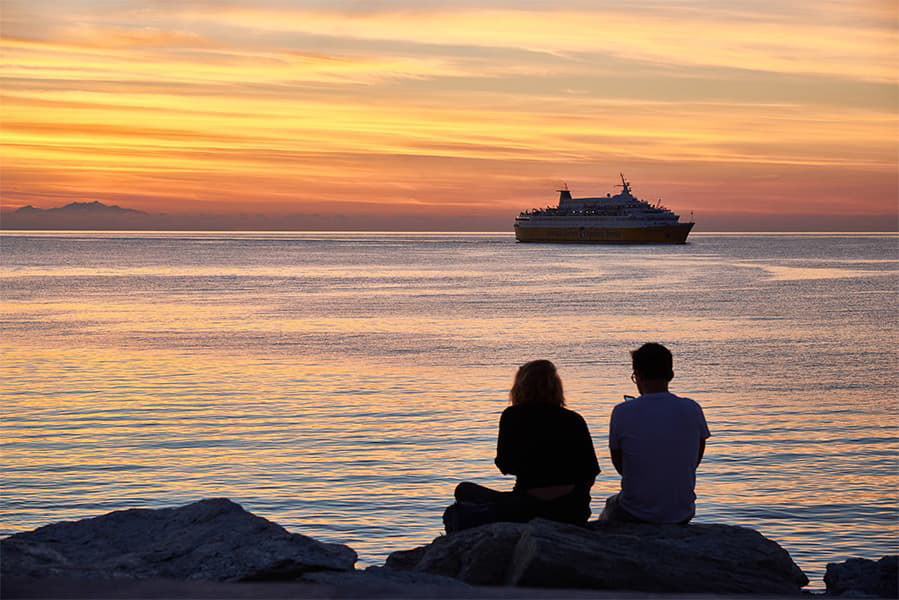Ferries from
Germany to Latvia
Ferries from
Germany to Latvia


The Travemunde to Liepaja ferry is the main ferry route from Germany to Latvia. Sailing frequency can change throughout the year and often sailings increase during peak season.
Ferries from Germany to Latvia sail approximately 5 times per week and are available with Stena Line.
The ferry from Germany to Latvia takes between 22 hours and 23 hours depending on the ferry route, operator, and ship that you choose.
The fastest ferry from Germany to Latvia is on the Travemunde to Liepaja ferry with Stena Line in 22 hours.
Yes, there are car ferries available from Germany to Latvia with Stena Line.
There are approximately 721 miles (1161km) and 627 nautical miles between Germany and Latvia.
The price of a ferry from Germany to Latvia can differ by route, operator, season, vehicle type and whether you are sailing on a high-speed ferry or conventional ferry.
The Travemunde to Liepaja ferry ferry sails approximately 6 times weekly with a crossing time of 22 hours.
We suggest that you book in advance to ensure that you get the cheapest ferry prices and availability. Please check out our special offers page to take advantage of all the latest ferry discounts available.
Book and compare Germany Latvia ferry tickets, operators, timetables and prices by using our Deal Finder.
| From | To | Average price | |
|---|---|---|---|
From TravemundeGermany |
To LiepajaLatvia |
Average price$275.22 |
More routes than anyone else.

Compare fares, times & routes in one place.
Change plans easily with flexi tickets.

Book e-tickets & manage trips in-app.
Live ship tracking & real-time updates.

Top-rated customer support when you need it.
Being the largest country in Central Europe, Germany offers even a casual visitor a wealth of sights and sounds from hyper modern and fashionable cities to the sublime southern regions that border the Alps. Beautiful, vibrant cities display some of the very best of what the country has to offer, while in the quieter corners of the country, the landscape is filled with significant UNESCO World Heritage sites and unspoiled treasures. With its prime position in the Baltic Sea, Germany is the perfect gateway to mainland Europe with ferries arriving from Scandinavia, Eastern Europe, and Russia. The ports of Kiel, Rostock and Travemunde are the more popular destinations and can be reached from Sweden, Denmark, Finland, Lithuania, Latvia and Norway. The port of Sassnitz is another option for those coming from Sweden and also provides a link from the island of Bornholm while Lubeck is destination for ferries departing on the long trip from Russia. The shortest and most frequently operated route to Germany is the 12 mile ferry link between Rødby (Lolland,Denmark) and Puttgarden, a village on the island of Fehmarn. The trip takes around 45 minutes and there are up to 2 sailings an hour. Poland is also a good alternative entry point for those travelling to Germany. Though some of the of the departure ports are the same as those used for the crossings to Germany, the schedule and duration at sea may be a better fit for your plans. If you're travelling from the UK to Germany, as the direct link from Harwich to Cuxhaven ceased many years ago, you'll need to travel via France, Belgium or Holland and drive across. Whether the country is your final destination or you’re just passing through, all of Germany's major towns and cities are well connected by major infrastructure, and offer many options for onward travel. The German motorway network covers some 7,500 miles ranking it among the most dense and longest highway systems in the world. For those that aren't travelling by vehicle, the German railway network is modern, comprehensive and very efficient, not just domestically but also for onward travel to countries all over Europe.
Latvia is a Baltic Nation in northern Europe, sandwiched between Estonia to the north and Lithuania to the south. With its turbulent Soviet rule now in the distant past, Latvia has thrived as one of Europe’s up and coming tourist destinations. Seemingly endless nature makes up the majority of the landscape, with unspoilt forests and sparkling lakes offering mouth-watering backdrops to any hike or bike ride. Latvia’s capital and primary cultural attraction, Riga is a cosmopolitan, cobblestoned city with a UNESCO World Heritage Site decorated old town. Straddling the Daugava River, it offers a mix of historical splendour and contemporary entertainment, boasting some excellent nightclubs alongside some wonderful, wooden architecture. For a relatively small country, Latvia has a few ports along its five hundred kilometre coastline, so it’s easy to reach by ferry. Across the Baltic Sea, there are numerous routes from countries in northern Europe and Scandinavia.